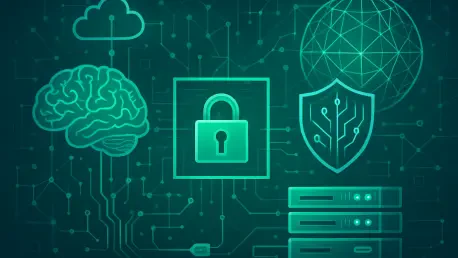In an era where cyber threats are becoming increasingly sophisticated and pervasive, Hewlett Packard Enterprise (HPE) has stepped forward with groundbreaking solutions that promise to redefine network security and data protection. At a major security conference this year, HPE showcased a suite of innovations powered by artificial intelligence (AI), designed to tackle the growing complexity of cyberattacks. These advancements come at a critical time when organizations across industries are grappling with the dual challenge of securing sprawling digital infrastructures and ensuring rapid recovery from potential breaches. By integrating AI into its offerings, HPE aims to provide a robust defense mechanism that not only anticipates threats but also streamlines operational responses. This unveiling marks a significant milestone in the ongoing battle against cyber risks, setting the stage for a deeper exploration of how technology can transform security landscapes.
Advancements in Network Security
Harnessing AI for Enhanced Protection
The spotlight at HPE’s recent presentation was on the integration of AI into network security frameworks, particularly through the introduction of the SASE Copilot for HPE Aruba Networking EdgeConnect. This innovative tool leverages AI to deliver real-time insights into network activities, identifying vulnerabilities before they can be exploited. By automating mundane tasks such as troubleshooting and report generation, the SASE Copilot empowers security and networking teams to focus on high-level strategic planning rather than getting bogged down in routine operations. This shift toward automation reflects a broader industry trend where AI is increasingly seen as a critical ally in managing complex network environments. The result is a significant boost in both efficiency and security posture, enabling organizations to stay ahead of potential threats in a landscape that demands constant vigilance and adaptability to new challenges.
Strengthening Zero-Trust Frameworks
Another pivotal aspect of HPE’s network security strategy is the enhancement of zero-trust principles through HPE Aruba Networking Central NAC. This solution extends policy enforcement across HPE Juniper Networking and even third-party devices, ensuring a comprehensive security net. Coupled with the AppEngine feature, it provides granular visibility into network operations, risk-based policy enforcement, and centralized control mechanisms. Such capabilities are vital in an era where continuous validation and anomaly detection are non-negotiable for safeguarding sensitive data. HPE’s commitment to a multi-layered security approach is evident in these advancements, which prioritize automated remediation to address threats swiftly. This focus on zero-trust architecture underscores the necessity for organizations to adopt dynamic, adaptive security measures that evolve alongside emerging cyber risks, ensuring robust protection across all touchpoints of their IT infrastructure.
Innovations in Data Protection and Recovery
Streamlining Recovery with Integrated Solutions
HPE’s dedication to data protection was highlighted with the announcement of the HPE Zerto Integration Hub, slated for release in the fourth quarter of this year. This hub is designed to connect seamlessly with cybersecurity software and enterprise networking devices, simplifying data protection and disaster recovery workflows. By automating integrations and reducing the operational overhead of managing disparate API connections, the hub addresses a critical pain point for many organizations. A notable collaboration with a leading threat detection platform further enhances this offering by combining advanced threat identification with cyber recovery capabilities. This integration allows businesses to restore applications and virtual machines to clean recovery points just before an attack, minimizing downtime. Such innovations are crucial for maintaining business continuity, especially in the face of ransomware and other destructive cyber incidents that can cripple operations.
Building Resilience with Comprehensive Storage Solutions
Further bolstering its data protection portfolio, HPE introduced the general availability of the Alletra Storage MP X1000 data protection package. This solution underscores a strategic focus on creating a unified security ecosystem that integrates seamlessly with other HPE offerings to tackle modern cyber challenges. The package is engineered to enhance data resilience, ensuring that organizations can recover swiftly from disruptions while maintaining the integrity of their critical information. Industry leaders from HPE emphasized the importance of such advanced solutions in mitigating risks and defending against sophisticated attacks. The efficiency gains from AI-driven automation within these tools were also highlighted as a game-changer, enabling teams to prioritize strategic initiatives over manual recovery processes. This comprehensive approach to data protection reflects an understanding of the interconnected nature of today’s IT environments, where resilience must be built into every layer of the infrastructure.
Reflecting on a New Era of Cybersecurity
Lessons from a Strategic Unveiling
Looking back at HPE’s showcase at the security conference, it was clear that a new chapter in cybersecurity had been opened through the strategic use of AI and integrated solutions. The introduction of tools like the SASE Copilot and the HPE Zerto Integration Hub demonstrated a forward-thinking mindset aimed at addressing both immediate and long-term threats. Collaborations with industry-leading platforms to enhance recovery capabilities stood out as a testament to the power of partnership in combating cyber risks. These efforts collectively positioned HPE as a frontrunner in delivering multi-layered security solutions that prioritized efficiency and adaptability, reflecting a deep understanding of the evolving threat landscape that organizations face daily.
Charting the Path Forward
As the dust settled on these announcements, the focus shifted to actionable next steps for organizations looking to fortify their defenses. Implementing AI-driven tools and zero-trust frameworks emerged as essential strategies for staying ahead of sophisticated cyberattacks. Exploring integrations that streamline recovery processes was also identified as a critical area for investment to ensure minimal disruption during incidents. HPE’s innovations offered a blueprint for building resilient IT environments, encouraging businesses to adopt a proactive stance in their security planning. Moving forward, the emphasis should remain on leveraging advanced technologies and strategic collaborations to anticipate and neutralize threats before they escalate, paving the way for a more secure digital future across industries.









